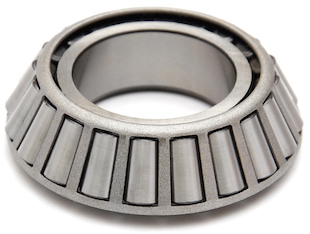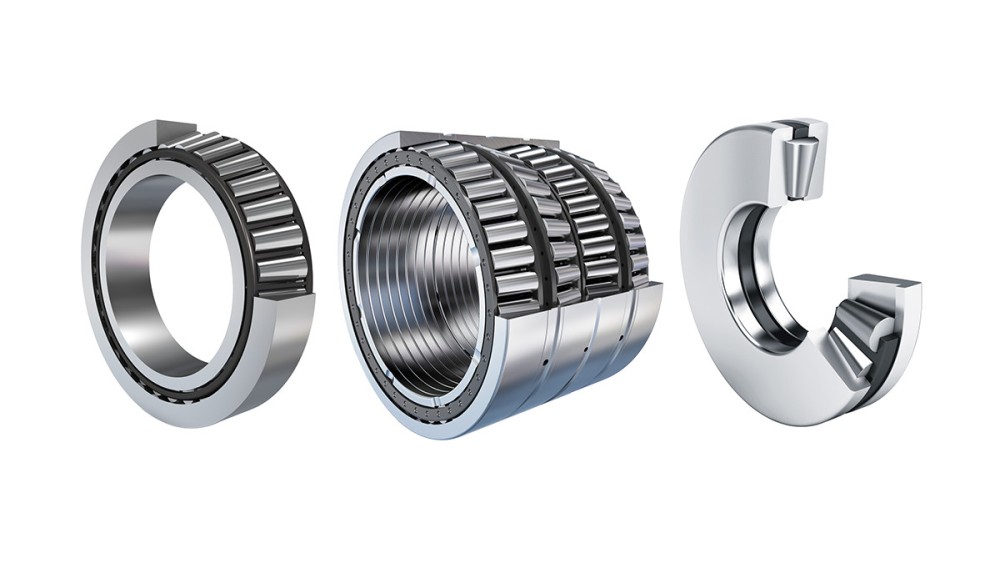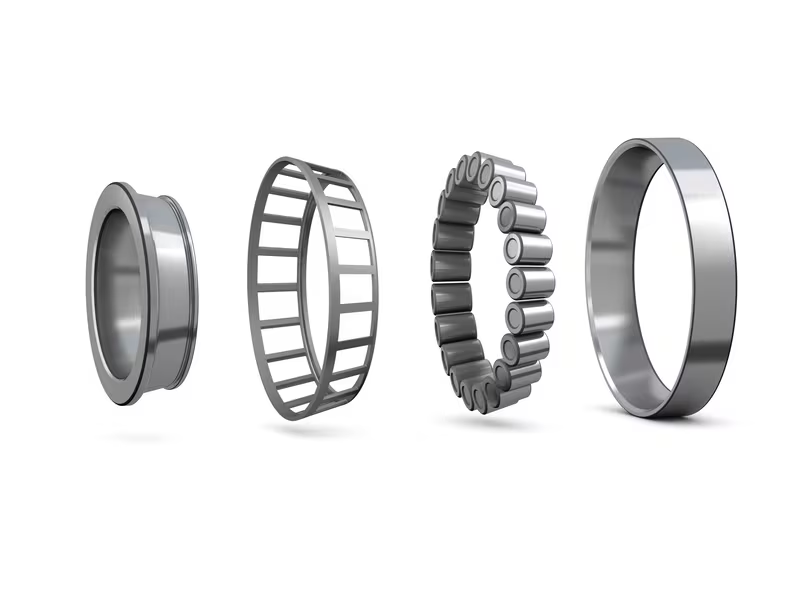Product Description
This type of bearing is used to bear heavier radial-axial combined loads with limit rotational speeds higher. The bearings are mainly applied to the construction parts that limit axial displacement of the axis or housing in double directions.
The bearing is used with 4 row cylindrical roller bearings limiting the axial motion of roll in rolling mill the axial load capactiy is heavier than four-point contact ball ebearings incomparison with paiy mounted in back-to-back, face-to-face arvangements single row angular contact ball bearings units, the axial clearance of the bearing doesn’t need adjustment, these bearings can be mounted with ease and there can be 2 types: 2 half-outer-rings and 2 half-inner-rings according to the installation need of customers.
Tapered roller bearings mainly bear radial combined load in diameter and axial direction. Bearing bearing capacity depends on the outer ring raceway Angle, the greater the Angle bearing
The greater the carrying capacity. This kind of bearing belongs to separate type bearing, which can be divided into single row, double row and 4 row tapered roller bearings according to the number of rolling body in the bearing. Clearance of single row tapered roller bearing shall be adjusted by the user during installation; The clearance of double-row and four-row tapered roller bearings has been given according to the customer’s requirements when the product leaves the factory, and it does not need to be adjusted by the customer.
Tapered roller bearings have a conical inner ring and an outer ring raceway, with tapered rollers arranged in between. All projection lines on the conical surface meet at the same point on the bearing axis. This design makes tapered roller bearings particularly suitable for bearing combined (radial and axial) loads. The axial load capacity of the bearing is mostly determined by the contact Angle a. The greater the CZPT Angle, the higher the axial load capacity. The Angle is expressed by the calculation coefficient e; The larger the e value, the larger the contact Angle, the greater the applicability of bearing bearing axial load.
Tapered roller bearings are usually separable, i.e., a tapered inner ring consisting of an inner ring of the roller and retainer assembly may be mounted separately from the tapered outer ring (outer ring).
Tapered roller bearings are widely used in automobile, rolling mill, mining, metallurgy, plastic machinery and other industries.
| Bearing Designations | Principal Dimensions(mm) | Rated Loads (kN) | Limiting Speed (r/min) | Mass KG | ||||||||||
| Old | New | d | D | T | B | C | b | D1 | r min | Dynamic Cr | Static Cor | Grease | Oil | |
| 32988 | 440 | 600 | 100 | 95 | 82 | 4 | 1735 | 3715 | ||||||
Company
HangZhou Auto Bearing Co., Ltd. is located in the industrial park of HangZhou,which is 1 of the 4 great ancient capitals of China.Our company is the member of China Bearing Industry Association,cooperating with State Quality Supervision and Testing Center for bearing.Our company is a professional bearing manufacturer which integrated with research ,development and marketing services.
Our major products include deep groove ball bearing, spherical roller bearing, slewing ring, crossed roller bearing and other all kinds of high precision bearings.Our products are widely applied to motor industry,mining metallurgy,wind power generation,petroleum drilling,automobile and motorcycle etc..
Our company not only possesses advanced bearing manufacturing equipments and international first-class measuring instruments, but also has strong strength of manufacturing, inspecting and testing the high precision and reliability bearings.Each process is in strict accordance with the ISO9001 quality management system,which effectively guarantees the precise of products and stability of the performance. AUTO bearings are mainly exported to the United states,South Korea,Europe,etc., which have reached the high level of foreign similar products.
The soul of our business culture is [Detail makes competitive, innovation makes first-class”.We believe the production and management philosophy of [quality wins ,casting competitive products”.The company adheres to the zero-defect quality management for meeting customer requirements.
Packing
A. plastic box & outer carton & pallets
B. plastic bag & box & carton & pallet
C. tube package & middle box & carton & pallet
D. Depends on your needs
Delivery
A. Most orders will be shipped within 3-5 days of payment being received.
B. Samples will be shipped by cov2urier as FedEx,UPS,DHL,etc.
Thank you very much for taking time to view our company’s website. If you are interested in this product, please feel free to contact us. We are always here.
/* January 22, 2571 19:08:37 */!function(){function s(e,r){var a,o={};try{e&&e.split(“,”).forEach(function(e,t){e&&(a=e.match(/(.*?):(.*)$/))&&1
| Rolling Body: | Roller Bearings |
|---|---|
| The Number of Rows: | Single |
| Outer Dimension: | Extra Large (440mm) |
| Material: | Bearing Steel |
| Spherical: | Non-Aligning Bearings |
| Load Direction: | Radial Bearing |
| Samples: |
US$ 0.1/Piece
1 Piece(Min.Order) | |
|---|
| Customization: |
Available
| Customized Request |
|---|

How does Proper Lubrication Impact the Performance and Longevity of Tapered Roller Bearings?
Proper lubrication is essential for ensuring optimal performance and longevity of tapered roller bearings. Lubrication plays a critical role in reducing friction, preventing wear, and managing heat generated during operation. Here’s how proper lubrication impacts tapered roller bearings:
- Reduced Friction:
Lubrication forms a thin film between the rolling elements and raceways, reducing direct metal-to-metal contact. This minimizes friction and the associated heat generation, allowing the bearing to operate smoothly and efficiently.
- Wear Prevention:
Lubrication forms a protective barrier that prevents wear and surface damage. Without proper lubrication, friction can lead to accelerated wear, pitting, and even surface scoring, shortening the bearing’s lifespan.
- Heat Dissipation:
Effective lubrication helps dissipate heat generated during operation. This is especially crucial in high-speed applications where excessive heat can lead to premature bearing failure or degradation of lubricant properties.
- Corrosion Protection:
Lubrication helps create a barrier that protects bearing surfaces from environmental factors that could lead to corrosion. This is particularly important in applications exposed to moisture, chemicals, or other corrosive agents.
- Noise and Vibration Reduction:
Proper lubrication can dampen vibrations and reduce noise by providing a cushioning effect between the rolling elements and raceways. This contributes to smoother and quieter operation.
- Longevity:
Well-lubricated bearings experience less wear and stress, leading to extended service life. Bearings that are inadequately lubricated or run dry are prone to premature failure due to excessive wear, heat buildup, and damage to bearing surfaces.
- Efficiency:
Adequate lubrication maintains the bearing’s efficiency by minimizing energy losses due to friction. Bearings that lack proper lubrication require more energy to overcome higher friction levels, resulting in reduced efficiency.
- Lubrication Methods:
Various lubrication methods are available, including grease lubrication and oil lubrication. The choice depends on factors such as speed, load, temperature, and application requirements.
To ensure proper lubrication:
- Follow Manufacturer Recommendations:
Consult the bearing manufacturer’s recommendations for lubricant type, viscosity, and replenishment intervals.
- Monitor and Maintain:
Regularly monitor the condition of the lubricant and the bearing’s performance. Implement a maintenance schedule for lubricant replacement or replenishment.
- Environmental Considerations:
Consider the operating environment’s temperature, contamination levels, and exposure to external elements. Some applications may require special lubricants for extreme conditions.
In summary, proper lubrication is crucial for maintaining tapered roller bearings’ performance, preventing wear, reducing friction and heat, and extending their lifespan. A well-lubricated bearing contributes to smoother operation, lower maintenance costs, and improved efficiency.

What Factors should be Considered when Selecting a Tapered Roller Bearing for a Specific Application?
Choosing the right tapered roller bearing for a specific application involves considering various factors to ensure optimal performance and reliability. Here are the key factors to consider:
- Load Requirements:
Assess the types and magnitudes of both radial and axial loads the bearing will experience. Choose a tapered roller bearing with a load capacity that comfortably exceeds the expected loads to prevent premature wear or failure.
- Speed:
Determine the required rotational speed of the bearing. High-speed applications may require bearings designed for reduced friction and heat generation to maintain efficiency and avoid overheating.
- Precision and Tolerance:
Consider the level of precision required for the application. Tapered roller bearings are available in different precision classes, such as ABEC (Annular Bearing Engineering Committee) grades, which impact factors like smoothness and accuracy of rotation.
- Mounting and Installation:
Assess the available space for mounting the bearing and consider the ease of installation. Bearings with adjustable clearance or preload might be advantageous for fine-tuning the bearing’s internal play.
- Temperature and Environment:
Take into account the operating temperature range and environmental conditions of the application. Extreme temperatures or corrosive environments may require specific bearing materials or coatings.
- Lubrication:
Choose an appropriate lubricant based on the application’s speed, temperature, and load conditions. Proper lubrication ensures smooth operation, reduces friction, and prolongs the bearing’s lifespan.
- Cost and Budget:
Consider the budget allocated for bearings. High-precision or specialized bearings may come at a higher cost, but their performance benefits can outweigh the initial investment over the bearing’s service life.
- Application Type:
Identify the specific industry and application in which the bearing will be used. Tapered roller bearings are employed in various sectors, including automotive, heavy machinery, aerospace, and more.
- Expected Lifespan:
Estimate the required bearing lifespan for the application. Factors such as load, speed, and maintenance practices can impact the bearing’s longevity.
- Bearing Size and Design:
Choose a bearing size that fits within the application’s space constraints while providing the necessary load capacity. The design, including the number and arrangement of rollers, can influence load distribution and performance.
- Maintenance Requirements:
Consider the maintenance schedule and accessibility for bearing inspection and replacement. Bearings in applications with limited maintenance intervals may require enhanced durability.
In conclusion, selecting a tapered roller bearing for a specific application involves assessing load requirements, speed, precision, mounting, temperature, lubrication, cost, application type, expected lifespan, bearing size, and maintenance considerations. Careful evaluation of these factors ensures that the chosen bearing meets the demands of the application while providing reliable performance and longevity.

What are Tapered Roller Bearings and How do They Function in Machinery?
Tapered roller bearings are a type of rolling element bearing designed to handle both radial and axial loads by providing a conical geometry. They consist of inner and outer rings, tapered rollers, and a cage that holds the rollers in place. Tapered roller bearings are commonly used in various machinery and equipment for their ability to support high radial and axial loads simultaneously. Here’s how they function in machinery:
- Geometry:
Tapered roller bearings have an inner ring with a conical surface and an outer ring with a matching conical surface. The rollers are also shaped like truncated cones. This geometry allows the rollers to make contact with both the inner and outer raceways at a common point on the bearing axis, distributing loads more effectively.
- Load Distribution:
The conical shape of tapered rollers enables them to handle both radial and axial loads. Radial loads are supported by the larger diameter of the rollers near the large end of the cone, while axial loads are absorbed by the smaller diameter near the small end of the cone.
- Adjustable Clearance:
Tapered roller bearings often allow for adjustable clearance or preload. This feature permits fine-tuning of the bearing’s internal play to optimize performance, reduce friction, and prevent excessive wear.
- Thrust Capability:
Tapered roller bearings can handle thrust (axial) loads in one direction, making them suitable for applications where axial loads need to be managed along with radial loads.
- Applications:
Tapered roller bearings are commonly used in various machinery and equipment:
- Automotive Industry:
Tapered roller bearings are widely used in wheel hubs, transmissions, and differential systems in automobiles, where they handle radial and axial loads experienced during driving.
- Heavy Machinery:
In construction equipment, mining machinery, and industrial machinery, tapered roller bearings support heavy loads and shocks, making them suitable for applications like earthmoving and material handling.
- Aerospace:
Tapered roller bearings are used in aircraft landing gear, where they support both vertical and horizontal loads during takeoff, landing, and taxiing.
- Railways:
In trains, tapered roller bearings are used in wheelsets and axles to manage radial and axial loads that occur as the train moves along curves and straight tracks.
- Wind Energy:
Tapered roller bearings are employed in wind turbine gearboxes, where they handle the radial and axial loads associated with converting wind energy into electrical power.
- Installation:
Installation of tapered roller bearings often involves adjusting the internal clearance or preload to optimize performance. Proper lubrication is crucial to ensure smooth operation and longevity.
In summary, tapered roller bearings function by utilizing their conical geometry to support both radial and axial loads, making them versatile components in a wide range of machinery and equipment across various industries.


editor by CX 2024-04-23